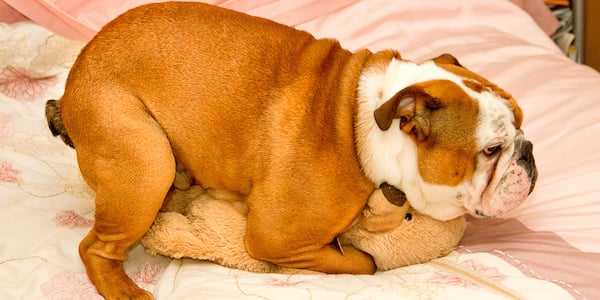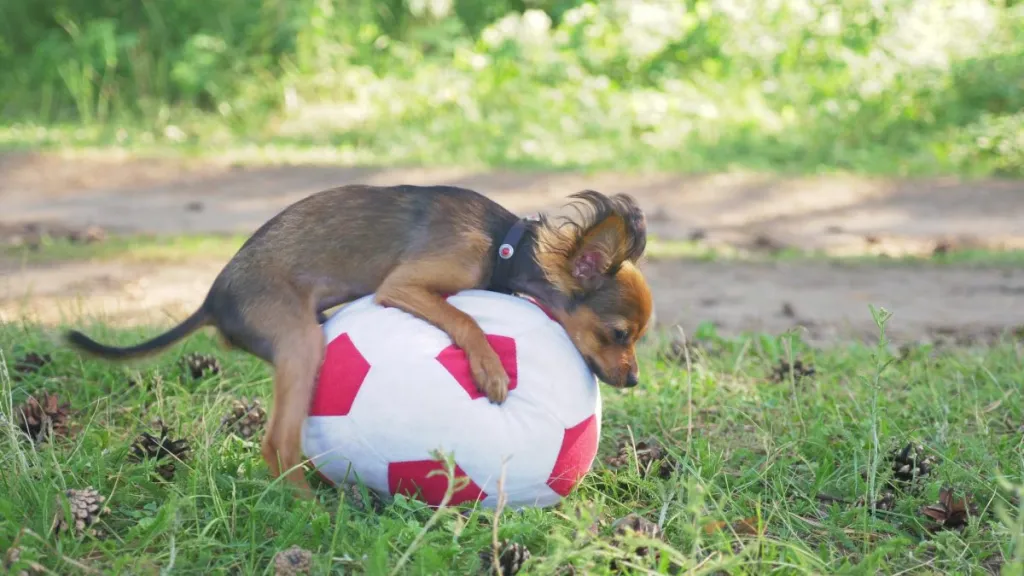Dog humping can occur due to various reasons, including excitement, anxiety, socialization problems, and even as a form of play. It is not always driven by hormones.
To stop this behavior, distractions can be used, such as redirecting their attention or giving them a time-out. Neutering can also help reduce sexual motivation in intact male dogs. Humping is a natural behavior, so it is important not to punish your dog for it, but rather provide support and guide them towards appropriate behaviors.
This article will discuss in detail why dogs hump and provide effective strategies to address and prevent this behavior.

Credit: www.preventivevet.com
Understanding Dog Humping
Understanding dog humping is important in order to address this behavior. It can be caused by excitement, playfulness, or even as a way of showing affection. To stop dog humping, it’s essential to redirect their attention, provide proper socialization, and consider neutering for intact male dogs.
Causes Of Dog Humping
Dog humping is a common behavior that can sometimes be confusing and even embarrassing for dog owners. It’s important to understand that humping can have various causes, including hormonal triggers, excitability and playfulness, socialization problems, and indicating playtime or love. Let’s take a closer look at each of these causes:Hormonal Triggers
Hormones play a significant role in dog humping behavior. Unneutered or unspayed dogs may exhibit humping as a way to assert their dominance or satisfy their sexual urges. In male dogs, testosterone can increase their inclination to mount other dogs, objects, or even people. Similarly, female dogs in heat may hump as a form of sexual behavior.Excitability And Playfulness
Humping can also occur when dogs are feeling excited or playful. It is not uncommon for dogs to engage in this behavior during playtime or after greeting other dogs. The excitement may trigger dogs to express their joy and high energy levels through humping. This type of humping is generally harmless and does not indicate any underlying behavioral issues.Socialization Problems
In some cases, humping may be a result of socialization problems. Dogs that haven’t been properly socialized may struggle with appropriate interaction skills, leading to mounting behavior. They might attempt to establish dominance or assert control over other dogs or even humans through humping. Addressing socialization issues through training and positive reinforcement can help reduce this behavior.Indicating Playtime Or Love
Believe it or not, humping can also be a way for dogs to indicate their desire for playtime or express their love. Some dogs hump their favorite dog friends or even their owners as a way to show excitement and initiate play. This type of humping is not accompanied by sexual arousal signs and is often seen in dogs with high energy levels. It’s important not to punish your dog for this behavior but rather redirect their attention to appropriate play activities. Understanding the causes behind dog humping is the first step in addressing and managing this behavior. Whether it’s due to hormonal triggers, excitability, socialization problems, or indicating playtime or love, it’s essential to approach the issue with patience, positive reinforcement, and professional guidance if needed. By doing so, you can help your dog overcome this behavior and create a harmonious relationship between you and your furry friend.
Credit: dogtime.com
Effects Of Dog Humping
Discover Why Dogs Hump and Learn Effective Ways to Stop It. Understand the various causes behind humping behavior, such as excitement, boredom, or stress, and find practical strategies to address and prevent it.
Embarrassment For Owners
Potential For Injury
Negative Impact On Social Interactions
Perception By Others
The effects of dog humping can be embarrassing for owners, potentially leading to discomfort and awkwardness in public settings. Seeing their beloved pet engage in this behavior can leave owners feeling worried about the judgments of others. The sight of a dog humping can draw attention and create an uncomfortable atmosphere, especially in social gatherings or public spaces. Furthermore, dog humping poses the potential for injury. Both the humping dog and the dog being mounted are at risk of physical harm. The humping dog may inadvertently hurt itself if it becomes too excited or engages in excessive force during the act. The dog being mounted may experience discomfort or even injuries from the humping dog’s actions. In addition to physical harm, the negative impact on social interactions is another effect of dog humping. It can lead to strained relationships between the dogs involved and their owners. Other dogs and their owners may avoid interactions, resulting in limited socialization opportunities for the humping dog and potential feelings of exclusion or isolation for its owner. The perception by others adds another layer of complexity to the effects of dog humping. Some people may view humping as a result of poor training or control, leading to negative judgments about the owner’s ability to manage their pet’s behavior. This can contribute to a decrease in confidence and self-esteem for the owner, further exacerbating the embarrassment and social impact of dog humping. Overall, the effects of dog humping extend beyond the behavior itself, impacting owners on multiple levels. From embarrassment and potential for injury to negative social interactions and perception by others, it is crucial for owners to understand why dog humping happens and how to stop it to alleviate these effects and create a more harmonious environment for both dogs and humans.How To Stop Dog Humping
Dog humping can be caused by various factors such as excitement, anxiety, or socialization issues. To stop this behavior, try creating distractions, giving your dog a time-out, or considering neutering if your dog is intact. Remember, humping is a natural behavior, so it’s important to provide support instead of punishment.
Distraction Techniques
Distracting your dog from humping can be an effective way to redirect their behavior. When you notice your dog starting to hump, use a distraction technique to shift their focus. This could involve calling their name, offering them a treat or toy, or engaging them in a game. By redirecting their attention, you can help break the humping habit. Remember to reward your dog for engaging in the desired behavior instead of humping.
Implementing Time Out
If distraction techniques don’t work, implementing a time out can help teach your dog that humping is not acceptable. When you catch your dog humping, calmly and gently remove them from the situation and place them in a designated time-out area, such as a crate or separate room. Leave them there for a short period, around 5 minutes, to allow them to calm down. This helps reinforce that humping leads to isolation and a loss of attention.
Exercise And Mental Stimulation
One reason dogs may hump is due to boredom or excess energy. Providing your dog with regular exercise and mental stimulation can help reduce humping behavior by keeping them physically and mentally satisfied. Take your dog for daily walks, engage in play sessions, and provide interactive toys or puzzles to keep their minds occupied. A tired and mentally stimulated dog is less likely to engage in humping.
Neutering Or Spaying
In some cases, humping behavior in dogs may be influenced by hormones. Having your dog neutered or spayed can help reduce their sexual motivation and potentially decrease humping tendencies. Consult with your veterinarian to determine if this option is suitable for your dog and to discuss the potential benefits.
Professional Training And Behavior Modification
If your dog’s humping behavior persists despite your efforts, it may be beneficial to seek professional help. A certified dog trainer or animal behaviorist can assess your dog’s specific situation and develop a tailored training plan to address the underlying causes of humping. They can provide guidance and strategies to modify your dog’s behavior effectively, leading to long-term results.
Handling Specific Scenarios
Discovering why dogs hump and learning effective techniques to stop this behavior is crucial for dog owners. While hormonal reasons can be a factor, humping can also be triggered by excitement or socialization issues. Understanding the underlying reasons and providing appropriate distractions or time-outs can help address this behavior.
Humping Visitors
When your dog starts humping your visitors, it can be quite embarrassing and uncomfortable for everyone involved. It’s important to address this behavior promptly to prevent any potential harm or awkward interactions. Here are a few steps you can take to handle this scenario:
- Redirect the behavior: As soon as you notice your dog trying to hump a visitor, quickly redirect their attention to a more appropriate behavior, such as sitting or offering a toy. This will help them understand that humping is not acceptable.
- Use positive reinforcement: Reward your dog for engaging in desired behaviors, such as sitting calmly or greeting visitors politely. This will reinforce good behavior and help them understand what is expected.
- Provide mental and physical stimulation: Make sure your dog is getting enough exercise and mental stimulation to release any pent-up energy. A tired dog is less likely to engage in inappropriate behaviors.
Humping Other Dogs
If your dog has a habit of humping other dogs, it’s important to address this behavior to maintain healthy social interactions. Here’s how you can handle this specific scenario:
- Interrupt the behavior: When you notice your dog attempting to hump another dog, calmly intervene and separate them. Use a distraction technique, such as calling their name, to redirect their attention.
- Allow proper socialization: Expose your dog to various social situations and provide opportunities for controlled interactions with other well-behaved dogs. This will help them learn appropriate play and communication skills.
- Consult a professional: If the humping behavior persists or escalates despite your efforts, seek guidance from a professional dog trainer or behaviorist who can offer customized advice and training methods.
Humping Humans
Humping humans can be uncomfortable and potentially embarrassing, especially when it happens in public. Here are some steps to handle this scenario:
- Redirect their attention: Similar to humping visitors, quickly redirect their attention to a more appropriate behavior, such as sitting or offering a toy, when they start humping humans.
- Establish boundaries: Teach your dog appropriate boundaries when interacting with humans. Ensure they understand that humping is not allowed and reward them for calm and polite behavior.
- Consistency is key: Enforce consistent rules and expectations across all human interactions. This will help your dog understand what behaviors are acceptable and what is not.
Humping Objects
Dogs may also exhibit humping behavior towards objects. While this behavior is not directed towards living beings, it’s still important to address it appropriately. Here’s what you can do:
- Provide appropriate outlets for energy: Ensure your dog gets enough physical exercise and mental stimulation to reduce any excess energy that may lead to humping objects.
- Limit access to objects: If your dog is fixated on humping a specific object, such as a pillow or plush toy, consider temporarily removing it from their environment until they learn to redirect their behavior.
- Redirect and distract: When you catch your dog humping an object, redirect their attention to a more engaging activity, such as playing with a toy or participating in interactive training sessions.
Remember, handling specific scenarios of humping behavior requires patience, consistency, and appropriate training techniques. By addressing the behavior promptly and providing positive reinforcement for desired behaviors, you can help your dog overcome this habit and promote healthier social interactions.
When To Seek Professional Help
Persistent Or Excessive Humping Behavior
Dogs humping is a natural behavior that can occur for various reasons. However, if your dog consistently engages in persistent or excessive humping behavior, it may be time to seek professional help. Persistent humping could indicate an underlying issue such as hormonal imbalances, anxiety, or even a sign of medical problems. Consulting with a professional dog trainer or veterinarian can help you understand the root cause of the behavior and develop an appropriate plan to address it.
Repetitive Humping In Inappropriate Situations
If your dog repeatedly humps in inappropriate situations, such as guests or children, it’s essential to address this behavior promptly. Repetitive humping in such situations can be a sign of dominance, territorial aggression, or lack of socialization. Seeking professional help from a certified dog behaviorist or trainer can assist in identifying the triggers and implementing strategies to retrain your dog’s behavior and ensure a safe and comfortable environment for everyone involved.
Aggression Or Other Behavioral Issues
Humping behavior, when accompanied by aggression or other behavioral issues, can be a cause for concern. If your dog becomes aggressive, possessive, or exhibits any other problematic behavior while humping, it is crucial to seek professional help. Aggression can stem from various factors, including fear, anxiety, or a history of trauma. A professional dog behaviorist or trainer can assess the situation, develop a tailored behavioral modification plan, and guide you through the process of rehabilitating your dog to ensure a happy and harmonious relationship.
:strip_icc()/why-do-dogs-hump-1118299_final-618ca6d647cc4517b66010e77abc2a38.jpg)
Credit: www.thesprucepets.com
Frequently Asked Questions On Dog Humping: Why It Happens And How To Stop It
What Are Reasons For Dogs To Hump?
Dogs hump for various reasons such as excitement, play, socialization issues, and to show affection. Hormones may play a role, but it’s not always the cause. Distractions, time-outs, and neutering can help stop the behavior. It’s important not to punish the dog, as humping is a natural behavior.
How Do I Stop My Dog From Ejaculating?
To stop your dog from ejaculating, consider neutering him. Neutering can reduce sexual motivation, especially during the presence of a female dog in heat. It may not completely eliminate mounting or masturbating behavior, but it can help. Remember that humping can occur due to various reasons, including excitement, anxiety, or socialization problems.
Don’t punish your dog for humping as it is a natural behavior. Instead, provide guidance and support when they feel overwhelmed.
What Does It Mean When My Dog Only Humps Me?
When your dog only humps you, it means they feel safe and want to play. It’s common in high-energy dogs, and not for sexual reasons. They are excited and showing their love for playtime.
Q: Why Do Dogs Hump?
A: Dogs may hump as a sign of excitement, playfulness, or to show dominance. It may also be a response to certain triggers, such as the presence of another dog or a favorite person.
Conclusion
Dog humping is a common behavior that can have various triggers, including excitement, playfulness, and even socialization issues. Understanding why your dog humps is essential in order to address the behavior effectively. While hormonal factors can play a role, humping is not always solely hormone-driven.
The best approach to stop humping is through using distractions, giving your dog a time-out, and providing proper training and socialization. Remember, humping is a natural behavior, so it’s important not to punish your dog for it but rather provide support and guidance.
By understanding the reasons behind humping, you can help your dog overcome this behavior and create a harmonious environment for both you and your furry friend.







